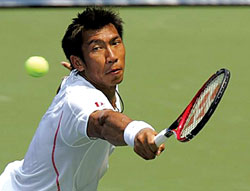 Early on in my playing career, the only strategy I knew was to run as fast I could and get the ball back over the net and wait for my opponents to make an error. As I moved on to play better players, I needed to add new strategies to be successful. Here are nine tips that will help you be a winner on the court.
Early on in my playing career, the only strategy I knew was to run as fast I could and get the ball back over the net and wait for my opponents to make an error. As I moved on to play better players, I needed to add new strategies to be successful. Here are nine tips that will help you be a winner on the court.
1 PLAY HIGH PERCENTAGE TENNIS
Reduce the number of points lost by unforced errors and increase the number of points by forcing your opponents into error. Unforced errors are mistakes made with no applied pressure from your opponent.Forced errors are the loss of point from applied pressure from your opponent.
2 KNOW THE ZONES
Use the traffic light analogy to understand the three zones on the court.
Red Zone: Baseline
Play safe and be consistent (Ground strokes with lots of spin and height)
Yellow Zone: Midcourt
Proceed through with caution (Approach shot)
Green Zone: Frontcourt
Go for it (Volleys and overheads)
3 KNOW YOUR TWO TARGET AREAS
Four quadrants: The closer you are to the net the greater the potential angle you have (130 degrees from the baseline as opposed to only 19.6 degrees two feet from the net) Height = Depth minus Aim at a 3-6 feet window over the net for depth.
4 BE CAUTIOUS WITH DIRECTION CHANGE
The difference between down the line shot and a crosscourt shot is 19.1 degrees. You have more chances for error while changing direction off a deep ball. Make sure you are well set up to pull the trigger up the line.
5 UNDERSTAND ERRORS
The best error to make is long. The worst error is the net and a close second is the wide error. Centre the ball with height and that will reduce the angle for your opponent as well cut down your errors.
6 ATTACK THE SHORT BALL
Once you have depth on your ground strokes, you will get short balls. You have got to attack them and get to the net to apply pressure on your opponent. The key is to understand how many steps it will take you to get into a good volley position by the time your approach shot bounces. You want to approach to the weaker and also the side where your opponent will hit higher and longer.
7 AWARENESS OF DEFENSIVE, NEUTRAL AND OFFENSIVE POSITION
Defensive position is when you are a foot or more behind the baseline. From this position, your goal is to get plenty of height on the ball and play crosscourt most of the time.
Neutral position is when you are on top of the baseline. From this position you can play consistently as well as seek chances to be aggressive and look for the down the line shots.
Offensive position is when you are a foot or more inside the base line and looking to attack a short ball and transition to the net.
8 HAVE A PLAN
You have to be able to adapt and change tactics and rhythm when needed in a match. If Plan A is working that is great, but if it is not working go to Plan B or C. It might be adding more or less top spin or varying the speed on your ground strokes. It could also mean serving and volleying instead of staying back or attacking a weak second serve and charging the net. You could also affect the rhythm of your opponent by playing slower or faster or taking the ball earlier to give less time.
9 SMILE AND HAVE FUN
Don't take tennis too seriously. After all, it's just a game.



